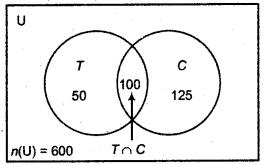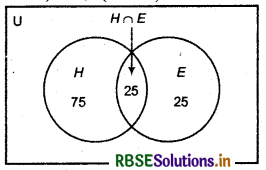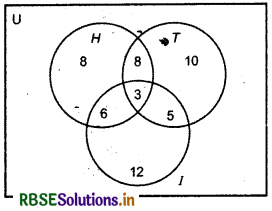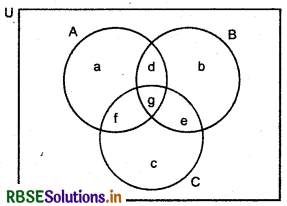RBSE Solutions for Class 11 Maths Chapter 1 Sets Miscellaneous Exercise
Rajasthan Board RBSE Solutions for Class 11 Maths Chapter 1 Sets Miscellaneous Exercise Textbook Exercise Questions and Answers.
Rajasthan Board RBSE Solutions for Class 11 Maths in Hindi Medium & English Medium are part of RBSE Solutions for Class 11. Students can also read RBSE Class 11 Maths Important Questions for exam preparation. Students can also go through RBSE Class 11 Maths Notes to understand and remember the concepts easily.
RBSE Class 11 Maths Solutions Chapter 1 Sets Miscellaneous Exercise
Question 1.
Decide, among the following sets, which sets are subsets of one and another :
A = {x:x ∈ R and x satisfy x2 - 8x +12 = 0}
B = {2, 4, 6}, C = {2, 4, 6, 8...............}, D = {6}
Answer:
Here A = {x:x ∈ R and satisfy x2 - 8x + 12 =0}
Solving x2 - 8x + 12 = 0
or x2 - 6x -2x + 12 = 0
or x(x - 6) - 2(x - 6) = 0
or (x - 6) (x - 2) = 0
∴ x = 6, 2
Thus, A = {2, 6}
and given B = {2, 4, 6},
C = {2, 4, 6, 8, ...............} ,
D = {6}
Thus, A is subset of B and C
A ⊂ B, A ⊂ C,B ⊂ C
and D ⊂ A, D ⊂ B, D ⊂ C
Question 2.
In each of the following, determine whether the statement is true or false. If it is true, prove it. If it is false, give an example.
(i) If x ∈ A and A ∈ B, then x ∈ B
(ii) If A ⊂ B and B ∈ C, then A ∈ C
(iiii) If A ⊂ B and B ⊂ C, then A ⊂ C
(iv) If A ⊂ Band B ⊄ C, then A ⊄ C
(v) If x ∈ A and A ⊄ B, then x ∈ B
(vi) If A ⊂ B and x ∉ B, then x ∉ A
Answer:
(i) Statement is false, since if A = {1, 2, 3} and B = {1, 2, 3}, 4}. Here A e B, since {1,2,3} is element of B but 1 ∉ B, 2 ∉ B and 3 ∉ B.
(ii) Statement is false, since if A = {1, 2}, B = {1, 2, 3} and C = {{1, 2, 3}, 4} then 4 ⊂ B,B ∈ C,then A ⊂ C since {1, 2} is not element in set C.
(iii) Statement is true, since A ⊂ B ⇒ x ∈ A and x ∈ B or B ⊂ C ⇒ x ∈ B and x ∈ C.
Also A = {a, b}, B = {a, b, c},C = {a, b, c, d}
Here x ∈ A ⇒ x ∈ B(A ⊂ B)
x ∈ B ⇒ x ∈ C(B ⊂ C)
Thus x ∈ A ⇒ x ∈ C
Thus A ⊂ C
(iv) Statement is false, if A = {a, b), B = {c, d, e} and C = {a, b,f}.
Here A ⊄ B and B ⊄ C, but A ⊂ C since both element of A occurs in C. Thus, A ⊄ B and B ⊄ C does not mean and A ⊄ C.
(v) Statement is false if
A = {3, 4}, B = {5, 6, 7}
Clearly 3 ∈ A and A ⊄ B then 3 ∈ B. Thus, x ∈ A and A ⊄ B does not means x ∈ B.
(vi) Statement is true, since ii A ⊂ B then all element of A will be element of B, x ∈ A ⇒ x ∈ B
Now, if any element not occurs in B then if will not be occurs in A, i. e.,
x ∉ B ⇒ x ∉ A
Thus, A ⊂ B then A ∉ B then x ∉ A.

Question 3.
Let A, B and C be the sets such that A ∪ B = A ∪ C and A nB = A nC, show that B = C.
Answer:
Given: A ∪ B = A ∪ C and A nB = A nC, then to prove B = C
∵ A ∪ B = A ∪ C
(A ∪ B) ∩ B = (A ∪ C) ∩ B
or (A ∩ B) ∪ (B ∩ B) = (A ∩ B) ∪ (C nB) (By distribution law)
or B = (A ∩ B) ∪ (C ∩ B) [∴(A ∩ B) ∪(B ∩ B) = B]
or B = {A ∩ B) ∪ (B ∩ C)
(∵ C ∩ B = B ∩ C) ...(1)
Again (A ∪ B) = (A ∪ C) (given)
or (A ∪ B) ∩ C = (A ∪ C) ∩ C
or (A ∩ C) (B ∩ C) = (A ∩ C) ∪ (C ∩ C) (By distribution law)
= C
or C = (A ∩ C) ∪ (B ∩ C) ...(2)
but A ∩ B = A ∩ C given,
In equation (2), replacing (A ∩ C) by (A ∩ B)
C = (A ∩ B) ∪ (B ∩ C) ...(3)
From equation (1) and (3),
B = C
Hence Proved
Question 4.
Show that the following four conditions are equivalent:
(i) A ⊂ B
(ii) A - B = Φ
(iii) A ∪ B = B
(iv) A ∩ B = A
Answer:
(i) Let A ⊂ B, then all elements of A are in set B. But A - B = {x:x ∈ A but x ∉ B}
(ii) Now A - B means elements of A which are not in B, but A ⊂ B then A - B = Φ.
Thus A ⊂ B and A - B = Φ are equivalent.
A - B = Φ ⇒ A ⊂ B
Hence Proved
(iii) Let A ∪ B = B
∵ A ⊂ B ∪ B
Thus A ⊂ B (∵ A ∪ B = B)
i.e., A ∪ B = B ⇒ A ⊂ B Hence Proved
(iv) Let A ∩ B = A
A ∩ B ⊂ B
A ⊂ B (∵ A ∩ B = A)
i.e., A ∪ B = A ⇒ A ⊂ B Hence Proved
Question 5.
Show that if AcB, then C -B ⊂ C -A
Answer:
Let x ∈ C - B ... (i)
⇒ x ∈ C and x £ B
⇒ x ∈ C and x ∈ A {∵ A ⊂ B}
⇒ x ∈ (C - A) ............(ii)
From (i) and (ii)
Hence Proved
Question 6.
Assume that P (A) = P (B), show that A = B.
Answer:
Let x ∈ A
{x} ⊂ A as well as {x} ⊂ P (A)
or {x} ⊂ P (B) {∵ P (A) = P (B)}
x ∈ B
A ⊂ B ...(1)
Again y ∈ B
{y} ⊂ B as well as {y} ⊂ P (B) or {y} ⊂ P(A) {∵ P (B) = P (A)}
y ∈ A ...(2)
From (1) and (2) A = B Hence Proved
Question 7.
Is it true that for any sets A and B .
P(A) ∪ P(B) = P(A ∪ B) Justify your answer.
Answer:
Let A and B are two sets and A = {1} and B = {a}
Now subsets of A and B are respectively Φ, {1} and Φ and {a}.
Thus, P(A) = {Φ,{1}} and
P(B) = {Φ, {a}}
Then, P(A) ∪ P(B) = {{Φ}{1} {a}} .............(1)
Now, A ∪ B = {1, a}
Subsets A ∪ B are Φ, {1}, {a} and {1, a}
Thus, P(A ∪ B)= {Φ, {1}, {a}, {1, a}} ...(2)
From Equation (1) and (2) P(A) ∪ P(B) ≠ P(A ∪ B)
Thus, given statement P(A) ∪ P(B) = P{A ∪ B) is not true.

Question 8.
Show that for any sets A and B
A = (A ∩ B) ∪ (A - B) and (A ∪ (B- A) = (A ∪ B)
Answer:
To prove for set A and B
A = (A ∩ B) ∪ (A - B) and A ∪ (B - A) = A ∪ B
(A ∩ B) ∪ (A - B) = (A ∩ B) ∪ (A ∩ B')
= A ∩ (B ∪ B') [∵ A ∩(B ∪ B') = (A ∩ B) ∪ (A ∩ B’) By distributive law]
= A ∩ U = A (∵ B ∪ B' = U) {A ∩ U = A} (∵ A ∩ U = A,v AcU)
Again thus, A = (A ∩ B) (A - B) (By distributive law)
L.H.S. = A ∪ (B - A)
Now,
A ∪ (B - A) = A ∪ (B ∩ A') (∵ B - A = B ∩ A')
= (A ∪ B) ∩ (A ∪ A') (By distributive law)
=(A ∪ B) ∩ U (∵ A ∪ A = U Universal set )
= A ∪ B
Thus, A ∪ (B - A) = A ∪ B
Hence Proved
Question 9.
Using properties of sets, show that:
(i) A ∪(A ∩ B) = A
(ii) A ∩ (A ∪ B) = A
Answer:
(i) We have to prove A ∪ (A ∩ B) = A
A ∪ (A ∩B) = (A ∪ A) ∩ (A ∪ B)
(By distubutive law)
= A ∩ (A ∪ B)
= A (∵ A ⊂ A ∪ B)
Thus, A ∪ (A ∩ B) = A
Hence Proved
(ii) We have to prove A ∪ (A ∪ B) = A
⇒ A ∩ (A ∪ B) = (A ∩ A) ∪ (A nB)
= A ∪ (A ∩ B) [∵ A ∩ BcA, A ∩A = A]
= A
Thus, A ∩ (A ∪ B) = A
Hence proved
Question 10.
Show that A ∩ B = A ∩ C need not imply B = C.
Answer:
It is not necessary for any sets A, B and C, A ∩ B = A ∩ C then B = C.
Let A = {1, 2}, B = {2, 3}, C = {2, 4}
Then, A nB = {2} and A ∩ C = {2}
Here ∴ A ∩ B = A ∩ C = {2}
Thus, it is not necessarily true that if A ∩ B = A ∩ C then B = C
Question 11.
Let A and B are sets; If A ∩ X = B ∩ X = Φ and A ∪ X = B ∪ X, for some set X, show that A = B. (Hints : A = A ∩ (A ∪ A),B = B ∩ (B ∪ X) and use distributive law.)
Solution:
Given A ∩ X = B ∩ X =§ and A ∪ X = B ∪ X, then show that A=B
Y A ∪ X = B ∪ X (Given)
⇒ A ∩ (A ∪ X) = A ∩ (B ∪ X)
= {A ∩ B) ∪ (A ∩ X) (By distributive law)
⇒ A ∩ (A ∪ X) = (A ∩ B) ∪ (B ∩ X) {∵ A ∩ X = B ∩ X, given)
⇒ A ∩ (A ∪ X) = (A ∩ B) ∪ (Φ) (∵ A ∩ X -B ∩ X) = Φ, given)
A = A ∩ B ...(1) [∵ A ∩ (A ∪ X) = A]
Since in set A and A ∪ X element of set A are common.
Again AKJX = B ∪ X given
⇒ B ∩ (A ∪ X) = B ∩ (B ∪ X)
⇒ (B ∩ A) ∪ (B ∩ X) = B ∩ (B ∪ X) (By distributive law)
⇒ (B ∩ A) ∪ Φ = B (∵ B ∩ X (B ∪ X) = B.A ∩ X = B ∩ X = Φ)
⇒ (B ∩ A) ∪ Φ = B [∵ (B ∩ A) ∪ Φ =B ∩ A]
⇒ B ∩ A = B ...(2)
By commutative law,
A ∩ B = B ∩ A From equation (1) and (2),
A = B Hence Proved
Question 12.
Find sets A, B and C such that A ∩ B,B ∩ C and A ∩C are non-empty sets and A ∩ B ∩ C = Φ.
Answer:
We have to find three sets A, B and C so that A ∩ B,B ∩ C and A ∩ C be non-empty sets and A ∩ B ∩ C = Φ
Three sets A, B, C are such that
A ∩ B ≠ Φ, B ∩ C ≠ Φ and A ∩ C ≠ Φ
∴ At least one element is common in A and B, similarly there will be at least one common element in B and C, as well as A and C.
We see that no element is common in A, B and C. Thus, A ∩ B ∩ C = Φ
Since, conditions are correct. So,
∴ Three sets are :A = {1, 2}, B = {2, 3} and C = {1, 3}
Question 13.
In a survey of 600 students in a school, 150 students were found to be taking tea and 225 taking coffee, 100 were taking both tea and coffee. Find how many students were taking neither tea nor coffee?
Answer:
Let T in set of students who drink tea and C who drink coffee. .
Questionwise, n(T) = 150, n(C) =225
n(T ∩ C) = 100

By formula n(T ∪ C) = n(T) + n(C) - n(T ∩ C)
= 150 + 225 - 100
n(T ∪ C) = 275
Now, 275 students drink tea or coffee. Thus, number of students who do not drink tea nor coffee.
= (T ∪ C)' = U - (T ∪ C)
= 600 - 275 = 325
∴ 325 students neither taken tea nor coffee.

Question 14.
In a group of students, 100 students know Hindi, 50 know English and 25 know both. Each of the students knows either Hindi or English. How many students are there in a group?
Answer:
Let H is set of students who speaks Hndi and E is set of students who speaks English.
Given, n(H) = 100, n(E) = 50 n(H ∩ E) =25, n(H ∪ E) = ?

Using formula,
n(H ∪ E) = n(H) + n(E) - n(H ∩ E)
n(H ∪ E) = 100 + 50 - 25
∴ n(H ∪ E) = 125
Thus, 125 students are there in the group.
Question 15.
In a survey of 60 people, it was found that 25 people read newspaper H, 26 read newspaper T, 26 read newspaper 1,9 read both H and 1,11 read both H and T, 8 read both T and 1,3 read all three newspapers. Find:
(i) the number of people who read at least one of the newspapers.
(ii) the number of people who read exactly one newspaper.
Answer:
Given n(U) = 60 .
n(H) = 25, n(T)=26, n(I) = 26
n(H ∩ I) = 9, n(H ∩ T) = 11 .
n(T ∩ I) = 8
n(H ∩ T ∩ I ) = 3
Venn diagram:

Using formula, we have to find number of people who read at first one of the two newspapers.
n(H ∪ T ∪ I) = n(H) + n(T) + n(T) - n(H ∩ T) - n(T ∩ I) - n(H ∩ I) + n(H ∩ T ∩ I)
= 25 + 26 + 26 - 9 - 11 - 8 + 3 = 52
Thus, number of people who read at least one newspaper is 52.
(ii) To find number of people who read exactly one newspaper.
Number of people who read H and T newspaper = n(H ∩ T) = 11
Number of people who read only H and T newpaper = n(H ∩ T) - n(H ∩ T ∩ C)
= 11 - 3 = 8
Similarly, number of people who read only T and I newspaper
= n(T ∩ I) - n(H ∩ T ∩ I)
= 8 - 3 = 5
Number of people who read only H and I newspaper = n(H ∩ I) - n(H ∩T ∩ I)
= 9 - 3 = 6
Now, number of people who read exactly two newspapers
= n(H ∩ T) - n(H ∩ T ∩ I) + n(H ∩ I) - n(H ∩ T ∩I) + n(T ∩ I) - n(H ∩ T ∩ I)
= (11 - 3) + (9 -3) + (8 - 3)
= 8 + 6 + 5 = 19
Here, number of people who read all three newspapers is not included.
Thus, number of people who read at least 2 Newspapers =19
Thus, number of people who read' at least two newspaper or all three papers.
= 19 + 3 = 22 .
Number of people who read at the least one newspaper = n(H ∪ T ∪ I) = 52
Number of people who read only one newspaper = n(H ∪ T ∪ I) - [n(H ∩ T) + n(H ∩ I) - n(H ∩ l ∩T) + n(T ∩ I) - n{H ∩ T ∩ I)] = 52 - 22
= 30 reads only only one newspapers
OR
In Venn diagram, number of reader of 1 newspaper = 8 + 10 + 12 = 30
Question 16.
In a survey it was found that 21 people liked product A, 26 liked product B and 29 liked product C, if 14 people liked products A and B, 12 people liked products C and A, 14 people liked products B and C and 8 liked all the three products. Find how many liked product C only.
Answer:
Consider the Venn diagram:

n(A)= 21 ⇒ a + d + f + g= 21 .........(i)
n(B)= 26 ⇒ b + d + e + g =26 .......(ii)
n(C) = 29 ⇒ c + e + f + g= 29 ............(iii)
n(A ∩ B) = 14 ⇒ d + g = 14 ...........(iv)
n(B ∩ C) = 14 ⇒ e + g = 14 ..............(v)
n(C ∩ A) = 12 ⇒ f + g = 12 ...........(vi)
n (A ∩ B ∩ C) = 8 ⇒ g = 8 .........(vii)
From (vi) and (vii) f = 4
(v) and (vii) e = 6
(iv) and (vii) d=6
Put e, f g in eq. (iii)
c + 6 + 4 + 8 = 29
c = 11
Therefore, 11 people liked product C only.

- RBSE Solutions for Class 11 Maths Chapter 3 त्रिकोणमितीय फलन Ex 3.1
- RBSE Solutions for Class 11 Maths Chapter 2 संबंध एवं फलन विविध प्रश्नावली
- RBSE Solutions for Class 11 Maths Chapter 2 संबंध एवं फलन Ex 2.3
- RBSE Solutions for Class 11 Maths Chapter 2 संबंध एवं फलन Ex 2.2
- RBSE Solutions for Class 11 Maths Chapter 2 संबंध एवं फलन Ex 2.1
- RBSE Solutions for Class 11 Maths Chapter 1 समुच्चय विविध प्रश्नावली
- RBSE Solutions for Class 11 Maths Chapter 1 समुच्चय Ex 1.6
- RBSE Solutions for Class 11 Maths Chapter 1 समुच्चय Ex 1.5
- RBSE Solutions for Class 11 Maths Chapter 1 समुच्चय Ex 1.4
- RBSE Solutions for Class 11 Maths Chapter 1 समुच्चय Ex 1.3
- RBSE Solutions for Class 11 Maths Chapter 1 समुच्चय Ex 1.2